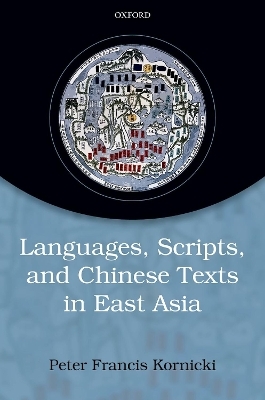
Languages, scripts, and Chinese texts in East Asia
Oxford University Press (Verlag)
978-0-19-879782-1 (ISBN)
Chinese Writing and the Rise of the Vernacular in East Asia is a wide-ranging study of vernacularization in East Asia - not only China, Japan, Korea, and Vietnam, but also societies that no longer exist, such as the Tangut and Khitan empires. Peter Kornicki takes the reader from the early centuries of the common era, when the Chinese script was the only form of writing and Chinese Buddhist, Confucian, and medical texts spread throughout East Asia, through the centuries when vernacular scripts evolved, right up to the end of the nineteenth century when nationalism created new roles for vernacular languages and vernacular scripts. Through an examination of oral approaches to Chinese texts, it shows how highly-valued Chinese texts came to be read through the prism of the vernaculars and ultimately to be translated. This long process has some parallels with vernacularization in Europe, but a crucial difference is that literary Chinese was, unlike Latin, not a spoken language. As a consequence, people who spoke different East Asian vernaculars had no means of communicating in speech, but they could communicate silently by means of written conversation in literary Chinese; a further consequence is that within each society Chinese texts assumed vernacular garb: in classes and lectures, Chinese texts were read and declaimed in the vernaculars. What happened in the nineteenth century and why are there still so many different scripts in East Asia? How and why were Chinese texts dethroned, and what replaced them? These are some of the questions addressed in Chinese Writing and the Rise of the Vernacular in East Asia.
Peter Francis Kornicki is the son of a Polish WWII Spitfire pilot and grew up in Malta, Aden, and Cyprus. He entered Lincoln College, Oxford, in 1968 to read Classics but transferred to studying Japanese after one year, taking a first class honours in Japanese with Korean in 1972. He received an MSc in Applied Social Studies, a DPhil in Japanese literature, and a DLitt, all from the University of Oxford, after which he taught at the University of Tasmania, Kyoto University, and the University of Cambridge. He was the President of the European Association of Japanese Studies from 1997 to 2000, a Fellow of the British Academy in 2000, and won the Yamagata Banto Prize in 2013.
Introduction
PART I: Orientations
1: Sinitic in a global perspective
2: Scripts and writing
3: The oral dimension
4: Material texts: manuscripts, xylography, and typography
5: Book roads and routes
PART II: Reading and translating
6: Reading Sinitic texts in the vernaculars
7: Written vernacular translation
PART III: Chinese texts and the vernaculars
8: The Chinese Buddhist canon and other Buddhist texts
9: Classics, examinations, and Confucianism
10: Primers, medical texts, and other works
Conclusion
| Erscheinungsdatum | 26.03.2018 |
|---|---|
| Zusatzinfo | 50 black and white figures/illustrations |
| Verlagsort | Oxford |
| Sprache | englisch |
| Maße | 164 x 242 mm |
| Gewicht | 806 g |
| Themenwelt | Geschichte ► Hilfswissenschaften ► Paläografie |
| Geisteswissenschaften ► Geschichte ► Regional- / Ländergeschichte | |
| Geisteswissenschaften ► Sprach- / Literaturwissenschaft ► Sprachwissenschaft | |
| ISBN-10 | 0-19-879782-6 / 0198797826 |
| ISBN-13 | 978-0-19-879782-1 / 9780198797821 |
| Zustand | Neuware |
| Haben Sie eine Frage zum Produkt? |
aus dem Bereich


